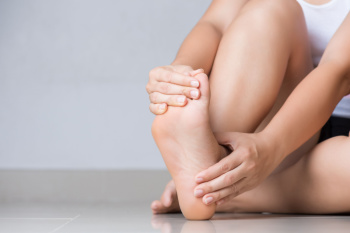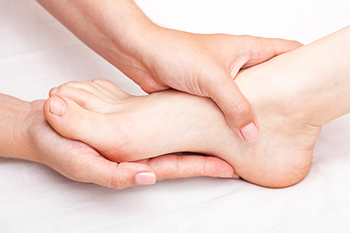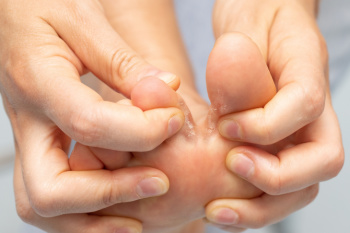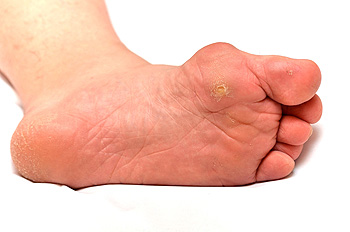February 2024
Enhance Flexibility With Toe Stretches

Stretching is not just beneficial for major muscle groups, but also for the often neglected toes, which play a vital role in maintaining balance and stability. Simple yet effective toe stretches can help alleviate discomfort, improve flexibility, and prevent common foot issues. Begin with the toe extension stretch by sitting comfortably and gently pulling each toe back, holding for a few seconds to feel the stretch along the top of the foot. Another beneficial stretch is the toe flexion stretch, where you sit and interlace your fingers between your toes, gently pressing them together to stretch the toe joints. Additionally, the toe spread exercise involves using your fingers to separate and stretch each toe outward, promoting better circulation and flexibility. If you are looking to learn about additional toe and foot stretches, it is suggested that you visit a podiatrist who can provide you with the knowledge you are seeking.
Stretching the feet is a great way to prevent injuries. If you have any concerns with your feet consult with one of our podiatrists from Port Richmond Family Footcare. Our doctors will assess your condition and provide you with quality foot and ankle treatment.
Stretching the Feet
Stretching the muscles in the foot is an important part in any physical activity. Feet that are tight can lead to less flexibility and make you more prone to injury. One of the most common forms of foot pain, plantar fasciitis, can be stretched out to help ease the pain. Stretching can not only ease pain from plantar fasciitis but also prevent it as well. However, it is important to see a podiatrist first if stretching is right for you. Podiatrists can also recommend other ways to stretch your feet. Once you know whether stretching is right for you, here are some excellent stretches you can do.
- Using a foam roller or any cylindrical object (a water bottle or soda can will do), roll the object under your foot back and forth. You should also exert pressure on the object. Be sure to do this to both feet for a minute. Do this exercise three times each.
- Similar to the previous one, take a ball, such as a tennis ball, and roll it under your foot while seated and exert pressure on it.
- Grab a resistance band or towel and take a seat. If you are using a towel, fold it length wise. Next put either one between the ball of your foot and heel and pull with both hands on each side towards you. Hold this for 15 seconds and then switch feet. Do this three times for each foot.
- Finally hold your big toe while crossing one leg over the other. Pull the toe towards you and hold for 15 seconds. Once again do this three times per foot.
It is best to go easy when first stretching your foot and work your way up. If your foot starts hurting, stop exercising and ice and rest the foot. It is advised to then see a podiatrist for help.
If you have any questions, please feel free to contact our office located in Lumberton, NJ, . We offer the newest diagnostic and treatment technologies for all your foot care needs.
What Is a Podiatrist?

A podiatrist specializes in treating foot, ankle, and lower limb conditions, providing care for ailments that can include fractures, nerve damage, and sports injuries. These doctors undergo extensive education, including a Doctor of Podiatric Medicine, or DPM, degree and residency training, focusing on lower extremity issues. Podiatrists diagnose and treat various conditions, from structural abnormalities to skin and nail disorders. Some podiatrists specialize in areas like orthotics, diabetes care, or surgery. They use diagnostic tools, such as imaging tests and sensory evaluations, to assess foot health accurately. Treatment options range from medication and injections to corrective footwear and surgery. Podiatrists are essential in managing foot-related issues. If you have a recent foot or ankle injury or are suffering with chronic discomfort in these areas, it is suggested that you schedule an appointment with a podiatrist for a proper diagnosis and treatment options.
If you are experiencing pain in the feet or ankles, don’t join the stubborn majority refusing treatment. Feel free to contact one of our podiatrists from Port Richmond Family Footcare. Our doctors can provide the care you need to keep you pain-free and on your feet.
What Is a Podiatrist?
Someone would seek the care of a podiatrist if they have suffered a foot injury or have common foot ailments such as heal spurs, bunions, arch problems, deformities, ingrown toenails, corns, foot and ankle problems, etc.
Podiatric Treatment
A podiatrist will treat the problematic areas of the feet, ankle or lower leg by prescribing the following:
- Physical therapy
- Drugs
- Orthotic inserts or soles
- Surgery on lower extremity fractures
A common podiatric procedure a podiatrist will use is a scanner or force plate which will allow the podiatrist to know the designs of orthotics. Patients are then told to follow a series of tasks to complete the treatment. The computer will scan the foot a see which areas show weight distribution and pressure points. The podiatrist will read the analysis and then determine which treatment plans are available.
If you have any questions please feel free to contact our office located in Lumberton, NJ, . We offer the newest diagnostic and treatment technologies for all your foot and ankle needs.
What Are the Causes and Symptoms of Athlete’s Foot?

Athlete's foot, a common fungal infection, affects the skin of the feet and thrives in warm, damp environments such as sweaty socks and communal showers. The primary cause is the fungus trichophyton, which spreads through direct contact with contaminated surfaces or through contact with infected individuals. The signs and symptoms of athlete's foot vary, but often include itching, burning sensations, and redness between the toes or on the soles of the feet. In some cases, blisters or cracked skin may develop, leading to discomfort and pain. If left untreated, athlete's foot can spread to other areas of the body and cause secondary infections. Proper hygiene practices, such as keeping the feet clean and dry, wearing breathable footwear, and avoiding walking barefoot in public areas, may help to prevent athlete's foot. Early recognition and management are key to resolving athlete's foot and preventing its recurrence. If you have any of the above symptoms, it is strongly suggested that you visit a podiatrist as quickly as possible who can provide you with the necessary medication for relief and treatment.
Athlete’s Foot
Athlete’s foot is often an uncomfortable condition to experience. Thankfully, podiatrists specialize in treating athlete’s foot and offer the best treatment options. If you have any questions about athlete’s foot, consult with one of our podiatrists from Port Richmond Family Footcare. Our doctors will assess your condition and provide you with quality treatment.
What Is Athlete’s Foot?
Tinea pedis, more commonly known as athlete’s foot, is a non-serious and common fungal infection of the foot. Athlete’s foot is contagious and can be contracted by touching someone who has it or infected surfaces. The most common places contaminated by it are public showers, locker rooms, and swimming pools. Once contracted, it grows on feet that are left inside moist, dark, and warm shoes and socks.
Prevention
The most effective ways to prevent athlete’s foot include:
- Thoroughly washing and drying feet
- Avoid going barefoot in locker rooms and public showers
- Using shower shoes in public showers
- Wearing socks that allow the feet to breathe
- Changing socks and shoes frequently if you sweat a lot
Symptoms
Athlete’s foot initially occurs as a rash between the toes. However, if left undiagnosed, it can spread to the sides and bottom of the feet, toenails, and if touched by hand, the hands themselves. Symptoms include:
- Redness
- Burning
- Itching
- Scaly and peeling skin
Diagnosis and Treatment
Diagnosis is quick and easy. Skin samples will be taken and either viewed under a microscope or sent to a lab for testing. Sometimes, a podiatrist can diagnose it based on simply looking at it. Once confirmed, treatment options include oral and topical antifungal medications.
If you have any questions, please feel free to contact our office located in Lumberton, NJ, . We offer the newest diagnostic and treatment technologies for all your foot care needs.
Medical Procedures for Foot Corns

Corns, which are hardened skin areas caused by friction, can be treated through various methods, but it is important to know that they will not disappear overnight. Conservative treatments involve reducing friction by changing shoes and trimming toenails properly. These are often effective in resolving corns. Surgical removal is reserved for severe cases when other treatments fail, and it is not recommended to attempt this on your own due to the risk of infection. Whether or not you should remove a corn depends on its impact on your daily life and overall health. Mild corns that do not bother you can be left alone, while severe symptoms may require podiatric evaluation, especially if you have conditions such as diabetes affecting foot sensation. Surgical options, cortisone injections, or podiatrist-assisted shaving are available for severe cases, with specific aftercare instructions. If you have a bothersome foot corn and symptoms persist, worsen, or interfere with your daily life, or if you have underlying health issues, it is suggested that you schedule an appointment with a podiatrist for more advanced treatment.
Corns can make walking very painful and should be treated immediately. If you have questions regarding your feet and ankles, contact one of our podiatrists of Port Richmond Family Footcare. Our doctors will treat your foot and ankle needs.
Corns: What Are They? And How Do You Get Rid of Them?
Corns are thickened areas on the skin that can become painful. They are caused by excessive pressure and friction on the skin. Corns press into the deeper layers of the skin and are usually round in shape.
Ways to Prevent Corns
There are many ways to get rid of painful corns such as:
- Wearing properly fitting shoes that have been measured by a professional
- Wearing shoes that are not sharply pointed or have high heels
- Wearing only shoes that offer support
Treating Corns
Although most corns slowly disappear when the friction or pressure stops, this isn’t always the case. Consult with your podiatrist to determine the best treatment option for your case of corns.
If you have any questions please feel free to contact our office located in Lumberton, NJ, . We offer the newest diagnostic and treatment technologies for all your foot and ankle needs.





